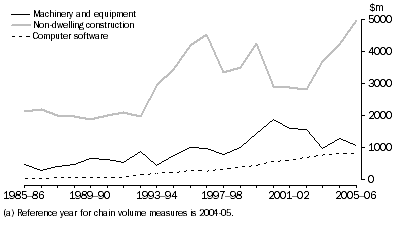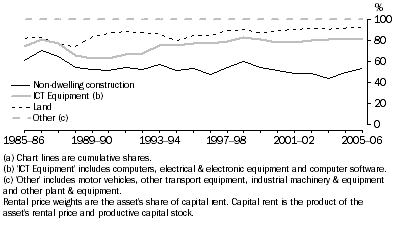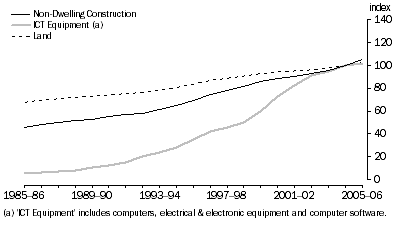CAPITAL INPUTS
The level of gross fixed capital formation (GFCF) in machinery and equipment in this industry was high between 1999-00 and 2002-03, with a significant decline since then. This investment coincided with the entry of new firms into the industry and likely contributed to the lower productivity growth during that period. The growth in capital inputs has been driven by computer equipment, electrical equipment and computer software capital formation (figure 12.3). GFCF is highest in non-dwelling construction but investment in ICT equipment has also had a significant impact on capital services.
12.3 COMMUNICATION SERVICES GROSS FIXED CAPITAL FORMATION BY ASSET TYPE, Chain volume measure (a)

GFCF in this industry follows technological advancements, with a cyclical profile coinciding with the introduction of new technologies. This is particularly true for non-dwelling construction, as investment in new physical networks is not a regular occurrence and usually follows significant technological advancements, whereas ICT equipment is more likely to be upgraded on a regular basis (PC 2001). The peaks in capital formation after 1997 were most likely related to the rollout of mobile phone and internet services by the larger providers; rather than as a result of new, smaller firms entering the market. It was during this time that the penetration of internet services began accelerating with the introduction of ADSL services to households in 2000.
The majority of machinery and equipment investment in this industry is in information & communications technology (ICT) equipment, such as computers & peripherals and electrical & electronic equipment. The price level of ICT equipment declined significantly between 1985-86 and 2005-06, with the price level of electrical & electronic equipment declining by 2.2% per year and computer software declining by 3.4% per year. Computer equipment declined in price by nearly 16% per year over the same period. Although the rental price of ICT equipment fell significantly due to the decline in price level of these assets, the rental price weight of this equipment increased significantly from 1985-86 to 2005-06, indicating that large volume increases are the main contributing factor to the increase in the rental price weight (Figure 12.4). The productive capital stock of ICT equipment increased significantly faster than either non-dwelling construction or land, which are the two other main assets held in this industry (Figure 12.5).
12.4 COMMUNICATION SERVICES RENTAL PRICE WEIGHTS (a)

12.5 COMMUNICATION SERVICES PRODUCTIVE CAPITAL STOCK BY ASSET, (2004-05 = 100)

 Print Page
Print Page
 Print All
Print All